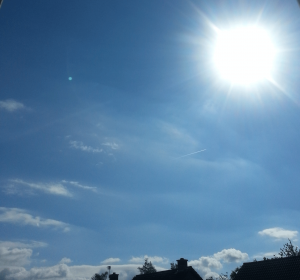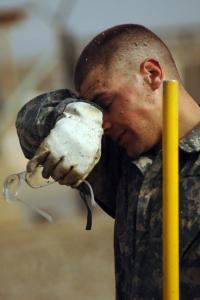Working in this heat and Heat Stress
Summer is well and truly here with record temperatures being recorded throughout the country.
But of course this heat, whilst enjoyed by many, can bring with it many problems for people at work from those outside in the constant sun to those having to work indoors and suffering from heat stress.
Working in this heat can affect your health in a number of ways.
This week we will tell you about:
- The risks from working out in the sun;
- The risks from working in hot areas indoors in this weather, for example in loft spaces;
- The precautions and controls you should adopt both as employer and employee.
This week’s 2 recent HSE cases look at:
- A Manchester-based roofer has been sentenced after breaching health and safety laws
- An engineering company was sentenced today after two employees were seriously injured during work to dispose of old gas cylinders at the company’s site in Hull.
As ever, if you have a subject that you would like us to cover one week, please contact us by phone 01458 253682, email or via our Facebook page or by Twitter.
Working in this Heat.
A sunny day makes most of us feel good, but too much sunlight can be hard on the skin and too much heat can cause Heat stress. But it’s a hot summer and the work needs to be done so what do you need to know and do?
To cover this we are going to look at working outside first and then at the problems facing indoor workers
Keep your top on
Health risks from working in the sun
A sunny day makes most of us feel good, but too much sunlight can be hard on the skin. It is not simply sudden exposure while on holiday that is harmful.
Even a tan that has been built up gradually can be harmful to health. A tan is a sign that the skin has been damaged.
The problem is caused by the ultraviolet (UV) rays in sunlight. People whose job keeps them outdoors for a long time, such as farm or building site workers, market gardeners, outdoor activity workers and some public service workers could get more sun on their skin than is healthy for them. Such people can be at greater risk of skin cancer.
What are the dangers?
In the short term…
sunburn can blister your skin and make it peel, but even mild reddening is a sign of skin damage.
In the long term…
too much sun will speed up the ageing of your skin, making it leathery, mottled and wrinkled, but the most serious effect is an increased chance of developing skin cancer.
Abnormal reactions to sunlight
Some medicines, contact with some chemicals used at work (such as dyes, wood preservatives, coal-tar and pitch products), and contact with some plants, can make your skin more sensitive to sunlight. Your works doctor or family doctor should be able to advise you further. Take this article with you.
Who is at risk of skin cancer?
To be perfectly honest the answer is EVERYBODY although some people are more liable to skin cancers than others. People with white skin are at most risk. Take particular care if you have:
- fair or freckled skin that doesn’t tan, or goes red or burns before it tans;
- red or fair hair and light coloured eyes;
- a large number of moles – 50 or more.
Workers of Asian or Afro-Caribbean origin are less at risk, but they should still take care in the sun to avoid damage to eyes, skin ageing and dehydration.
What can you do to protect yourself?
Even if your skin is not fair and freckled, you should still be particularly careful while you are working out of doors in the summer in the three or four hours around midday. The sun is most intense at these times. Even on cloudy days, UV can filter through.
Some Dos and Don’ts to avoid the dangers are:
- Do try to avoid the mild reddening which is a sign of skin damage as well as being an early sign of burning.
- Do try to work and take your breaks in the shade if you can – this will reduce your risk of harming your skin and also help to keep you cool.
- Do continue to take care when you go on holiday – your skin remembers every exposure.
- Don’t be complacent; get to know your skin’s most vulnerable areas (e.g. back of neck, head) and keep them covered.
- Don’t try to get a tan – it’s not a healthy sign. It might look good but it indicates that the skin has already been damaged. A suntan does not eliminate the long term cancer risk which is associated with prolonged exposure to the sun; nor will it protect against premature ageing.
Clothing
Cover up. Ordinary clothing made from close-woven fabric, such as a long-sleeved work shirt and jeans, will stop most of the UV.
Wear a hat. A wide-brimmed hat will shade your face and head, the areas which suffer most from sunlight. A safety helmet will provide some shade for the head. A hanging flap can protect the back of your neck.
Keep your shirt on, especially while you are working around midday. Don’t be tempted to leave it off, even if your skin tans easily and does not burn.
Sunscreens
Hats and other clothing are the best form of protection, but sunscreen creams and lotions can add useful protection for parts of your body that are not easy to shade from the sun. Look for a sun protection factor (SPF) rating of 15 or more as it protects against UVA and UVB.
Read the supplier’s instructions on how it should be applied. Don’t forget the backs of your hands.
Check your skin
The first warning sign is often a small scabby spot which does not clear after a few weeks. Look for changed or newly formed moles or any skin discolouration. It is normal for new moles to appear until you are about 18 years old. As an adult you should pay particular attention to any growths which appear on the face, especially around the nose and eyes, or on the backs of the hands; you should show your doctor any moles which change in size, colour, shape or start to bleed.
If you notice any of these signs consult your own doctor, or your works medical department if you have one.
Heat stress from working indoors
In this section of the article we look at the possible effects of the heat to those working indoors, especially those working in hot places like a bakery or dry cleaners or those working in confined spaces such as the attic. These people are not exposed to the same risks as those working outside. Instead they are more prone to suffering from heat stress
What is heat stress?
Heat stress occurs when the body’s means of controlling its internal temperature starts to fail. Air temperature, work rate, humidity and work clothing are all factors which can cause heat stress. It may not be obvious to someone passing through the workplace that there is a risk of heat stress.
How does the body react to heat?
The body reacts to heat by increasing the blood flow to the skin’s surface and by sweating. This cools the body as heat is carried to the surface from within by the increased blood flow and sweat evaporates. Heat can also be lost by radiation and convection from the body’s surface.
Typical example of a heat stress situation
Someone wearing protective clothing and performing heavy work in hot and humid conditions could be at risk of heat stress because:
- Sweat evaporation is restricted by the type of clothing and the humidity of the environment.
- Heat will be produced within the body due to the work rate and if insufficient heat is lost deep body temperature will rise.
- As deep body temperature rises the body reacts by increasing the amount of sweat produced, which may lead to dehydration.
- Heart rate also increases which puts additional strain on the body.
- If the body is gaining more heat than it can lose then the deep body temperature will continue to rise. Eventually it reaches a point where the body’s control mechanisms start to fail.
The symptoms will get worse the longer someone remains working in the same conditions.
What are the effects of heat stress?
Heat stress can affect individuals in different ways and some people are more susceptible to it than others.
Typical symptoms are:
- an inability to concentrate;
- muscle cramps;
- heat rash;
- severe thirst – a late symptom of heat stress;
- fainting;
- heat exhaustion – fatigue, giddiness, nausea, headache, moist skin;
- heat stroke – hot dry skin, confusion, convulsions and eventual loss of consciousness. This is the most severe disorder and can result in death if not detected at an early stage.
Where does heat stress occur?
Examples of workplaces where people might suffer from heat stress because of the hot environment created by the process or restricted spaces are:
- glass and rubber manufacturing plants;
- mines;
- compressed air tunnels;
- in loft areas;
- conventional and nuclear power stations;
- foundries and smelting operations;
- brick-firing and ceramics plants;
- boiler rooms;
- bakeries and kitchens;
- laundries and dry cleaners.
In these industries working in the heat may be the norm. For others it will be encountered less often depending on the type of work being done and changes in the working environment, e.g. seasonal changes in outside air temperature can contribute significantly to heat stress.
What do I need to do about heat stress?
Over time people can adapt to hot conditions by sweating more and changing their behaviour to try and cool down, e.g. removing clothing, taking cool drinks, fanning themselves, sitting in the shade or a cool area, and/or reducing their work rate. However, in many work situations such changes may not be possible, e.g. when protective clothing has to be worn.
Where there is a possibility of heat stress occurring you will need to consider this when carrying out your risk assessment.
What do I need to look at in the risk assessment?
When carrying out your risk assessment, the major factors you need to consider are:
- work rate – the harder someone works the more body heat they generate;
- working climate – this includes air temperature, humidity, air movement and effects of working near a heat source;
- worker’s clothing and respiratory protective equipment – may mean that sweating and other means of the body regulating its temperature are less effective;
- worker’s age, build and medical factors – may affect an individual’s tolerance.
Firstly, talk to the workers involved to see whether they are suffering early signs of heat stress. If there is a problem, you may need to get help from others who are more experienced in determining the risk from hot environments, e.g. occupational hygienists or occupational health professionals.
How can I reduce the risks?
- Remove or reduce the sources of heat where possible:
- Control the temperature using engineering solutions, e.g. change the processes, use fans or air conditioning, use physical barriers that reduce exposure to radiant heat.
- Provide mechanical aids where possible to reduce the work rate.
- Regulate the length of exposure to hot environments by:
- allowing workers to enter only when the temperature is below a set level or at cooler times of the day;
- issuing permits to work that specify how long your workers should work in situations where there is a risk;
- providing periodic rest breaks and rest facilities in cooler conditions.
- Prevent dehydration. Working in a hot environment causes sweating which helps keep people cool but means losing vital water that must be replaced. Provide cool water in the workplace and encourage workers to drink it frequently in small amounts before, during (where possible) and after working.
- Provide personal protective equipment. Specialised personal protective clothing is available which can incorporate personal cooling systems or breathable fabrics. The use of some protective clothing or respiratory protective equipment may increase the risk of heat stress.
- Provide training for your workers, especially new and young employees, telling them about the risks of heat stress associated with their work, what symptoms to look out for, safe working practices and emergency procedures.
- Allow workers to acclimatize to their environment and identify which workers are acclimatized or assessed as fit to work in hot conditions.
- Identify employees who are more susceptible to heat stress because of an illness, condition or medication that may contribute to the early onset of heat stress, e.g. pregnant women or those with heart conditions. You may need advice from an occupational health professional.
- Monitor the health of workers at risk. Where a residual risk remains after implementing as many control measures as practicable, you may need to monitor the health of workers exposed to the risk. You should then seek advice from an occupational health professional.
If you are an employer who is unsure if they are protecting their employees enough in this heat, or maybe you just want some more advice about your legal duties, then drop an email to our CEO Jon Wilkins on [email protected] or call the office on 01458 253682.
Taunton & Somerset CPD Group at The Exchange House Taunton
The meetings will take a break over July and August as in previous years, returning in September when we aim to have them fortnightly.
Training Courses
These are also taking a break over July and August although we are always available for “In House” courses
Introducing our latest team member.
Peter M Bushnell Dip NEBOSH Grad IOSH
Peter has very strong communication skills and takes the stance of “There is always a solution” He is a good decision-maker who is passionate, yet very practical about OH&S. He gives solutions to real-issues and has assisted many companies to improve OH&S.
Over the years Peter has attained his NEBOSH Diploma and following that, Behavioural Health and Safety Professional, Human Behavioural system and control, and many training qualifications.
This year (2018) Peter has completed the ISO 45001:2018 OH&S Management Systems Auditor/Lead Auditor Training Course. Indeed, we believe he is one of the first to complete this course in the UK.
With Peter we can now assist companies to achieve an ISO 45001 accreditation. When put into logical steps, making sure each step is understood before moving on, the whole process can be easier to follow and therefore understand. This enables the company to more smoothly achieve their ISO 45001 accreditation. If you are already working towards accreditation but just require an external auditor, Peter can oblige.
Peter can also assist clients in such areas as Water Systems, Listeria, DAF Systems, Height Access, Cranes lifts – HIAB and Working at High Systems
